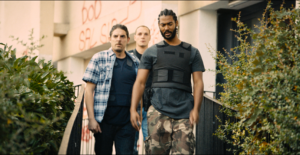Bâtiment 5
(Les Indésirables)
2023

FR EN
Un grand ensemble parmi d’autres, niché quelque part en banlieue, victime agonisante des politiques urbaines. Y trône le Bâtiment 5, habité notamment par Haby, jeune femme investie dans la vie publique et associative de son quartier. Lorsqu’elle apprend que sa barre d’immeuble est menacée de destruction par la mairie, Haby ne peut pas rester sans rien faire.
« Bâtiment 5 » s’ouvre, s’entrecoupe et se ferme sur des plans larges – et tournés à l’aide d’un drone – de ce mastodonte de béton qui donne son nom au second long-métrage de Ladj Ly, réalisateur des « Misérables ». D’inspiration autobiographique, « Bâtiment 5 » nous présente ici tous les enjeux du mal-logement dans les cités, incarné non seulement par son immeuble-modèle, mais aussi par tous les personnages qui suivent de près comme de loin sa longue et lente dégradation.
D’un côté, l’on retrouve ainsi un maire récemment [non] élu, désinvolte voire méprisant (Alexis Manenti) qui cherche à détruire le bâtiment. À ses antipodes se trouve Haby (Anta Diaw) qui vit jusque dans sa chair l’abandon, le rejet et la haine que ressentent et subissent ses voisins et proches – comme Blaz (Aristote Luyindula) dont la colère et le désespoir saisissent par leur puissance et leur violence. Tandis qu’au milieu de tout cela, des intermédiaires ambivalents – comme Roger (Steve Tientcheu), le premier adjoint au maire – encaissent les antagonismes.
Bien qu’il y ait un parti pris, rien n’est blanc ni noir dans ce film : Ladj Ly parvient à décortiquer la complexité de la situation des banlieues, où s’entremêlent rêves et dures réalités, où un simple enterrement peut être plus difficile qu’ailleurs, où une étincelle peut être synonyme d’espoir comme de ras-le-bol, où la violence peut surgir de tout et de rien, où les combats peuvent laisser place à la résignation – et vice-versa.
La figure de Haby, à ce titre, est un pilier de l’intrigue. Une juste, une prophétesse qui connaît parfaitement son monde et qui souhaite l’améliorer pas à pas. Ses discours et ses dialogues, parfois cinglants, nous touchent, nous révèlent, nous révoltent contre cet état des choses qu’il faut changer. « Bâtiment 5 » forme ainsi un conte moderne, gris et dégrisant, porté par “une Française d’aujourd’hui” et dont nous espérons qu’il se terminera bien…
Axel Chevalier
One of many large housing estates tucked away somewhere in the suburbs, a dying victim of urban policies. Haby, a young woman involved in her neighborhood’s public and community life, lives in Building No. 5. When she learns that her block of flats is threatened with demolition by the local council, Haby just can’t stand by and do nothing.
“Les Indésirables” (literally “Building N°5” in French) opens and closes with wide shots – captured by drone – of the concrete behemoth that gives its name to the second feature film by Ladj Ly, director of “Les Misérables”. Based on his own experience, “Les Indésirables” takes us through all the issues surrounding poor housing on housing estates, embodied not only by its flagship building, but also by all the characters who follow its long, slow deterioration up close and from afar.
On the one hand, there’s the recently [not] elected mayor, who is casual and even contemptuous (Alexis Manenti) and wants to demolish the building. At the other end of the spectrum is Haby (Anta Diaw), who feels the abandonment, rejection and hatred felt and endured by her neighbors and loved ones – like Blaz (Aristote Luyindula), whose anger and despair are striking in their power and violence. Meanwhile, in the midst of all this, ambivalent intermediaries – like Roger (Steve Tientcheu), the first deputy mayor – deal with the conflicting interests.
Ladj Ly succeeds in deconstructing the complexity of the situation in the suburbs, where dreams and harsh realities are intertwined, where a simple funeral can be more difficult than elsewhere, where a spark can be synonymous with hope or frustration, where violence can arise out of anything and everything, where fighting can give way to resignation – and vice versa.
In that respect, the figure of Haby is a key figure in the plot. A righteous woman, a prophetess who knows her world inside out and wants to improve it step by step. Her speeches and dialogues, some of them scathing, move us, inspire us and revolt us against the way things are and the need to change them. “Les Indésirables” is a modern, grey and sobering tale told by a « modern-day French woman », and one that we hope will reach a happy ending…
Axel Chevalier

